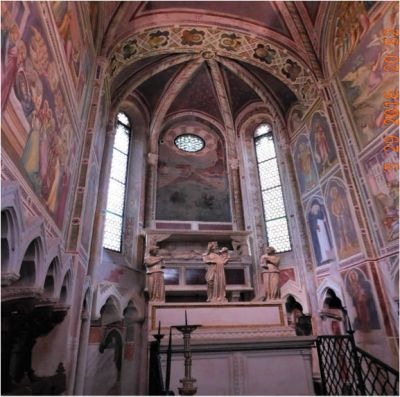Una visita a Padova rappresenta un viaggio tra passato e presente, tra storia millenaria, tradizioni e arte. Una città ricca di bellezze, è nota per gli affreschi di Giotto della Cappella degli Scrovegni, per la grande Basilica di Sant’Antonio del XIII secolo che ospita la tomba del santo a cui è intitolata, per le sculture del Donatello o le più moderne linee del monumento di Libeskind. E’ un percorso tra la magnificenza degli antichi palazzi, nella spiritualità che si respira nelle sue Chiese ed tra il quotidiano brulicare dei mercati cittadini di Piazza delle Erbe e Piazza della Frutta, tra l’imponenza di Prato della Valle e sotto i millenari portici. Padova è anche la città della scienza che si sviluppa tra le antiche mura della sede universitaria del Palazzo del Bo e lungo i viali dello primo Orto Botanico universitario d’Europa. La sua cucina da un lato si rifà a quella veneziana, di cui conserva sapori e tradizioni, e dall’altro è legata alla campagna e alla fiorente agricoltura. Le eccellenze dell’enogastronomia padovana sono certificate dal marchio di qualità Padova che stabilisce i criteri per garantire l’assoluta tipicità, genuinità e rintracciabilità dei suoi prodotti enogastronomici.
Padua, in the Veneto region of Italy, is not the first city most visitors put on their wish list. It can be a quick day trip from Venice or a longer stay to appreciate the churches, museums, markets, and cafes.
After arriving in Pauda via train from Venice or many other cities, the city center is a short walk from the station to the pedestrian-only center, bustling with locals shopping or enjoying an outdoor café. Without the flag-waving tour guides that you find in other tourist meccas, you might be in any Italian market town.
An entire visit to Padua can be spent at the Musei Civici (Museo Civico) complex where the unique Cappella degli Scrovegni (the Scroveni Chapel) can be visited. Inside the chapel are floor to ceiling frescos by Giotto. Enrico degli Scrovegni, a banker in Padua in the 1300’s, built the chapel as part of the family palace complex. Scrovegni commissioned Giotto, an Italian painter and architect from Florence generally considered the first in a line of great artists who contributed to the Italian Renaissance, to decorate the interior of the chapel. The theme of the frescos inside the chapel is the life of the Virgin Mary. The frescos are scenes from the Annunciation, Visitation, marriage at Cana, raising of Lazarus, expulsion of the money lenders, and the last supper to the crucifixion and resurrection and many more. An art instructor could spend a class on each panel although each visitor has only 15 minutes! You may be overwhelmed by the sheer number of individual figures, each with a specific facial expression or the vibrant colors throughout the chapel.
There was far too much to see and appreciate in our short period of time. Photos without flash are permitted so recording each panel allowed me to review them later when I could also read about the message in each panel. You can also purchase one of the guide books at the entrance to the museum complex, several of which are in English. There is also an inventive audio map you can rent for your visit. When you point the special pen to the map for the portion of the chapel you wish to learn about, the pen gives you the information. But remember to complete your information review before you visit the chapel as you will only be allowed to remain inside for 15 minutes.
https://www.lagazzettaitaliana.com/travel/8858-padua-safeguards-amazing-giotto-treasures#sigProId61b3459ead




